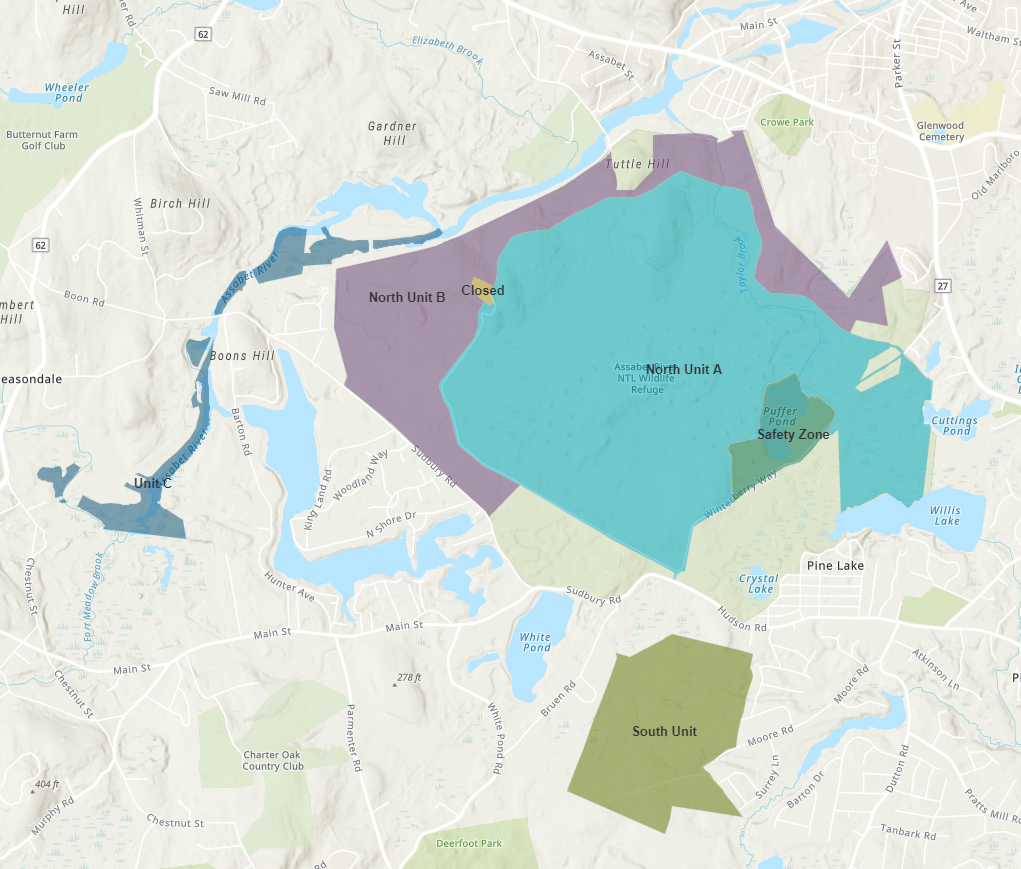by Ann Needle
The federal government has proposed opening up more hunting opportunities at its wildlife refuges, which would include the Assabet River and other nearby National Wildlife Refuges. Residents have until May 22 to voice their opinion to the U.S. government.

North Unit A 1332
North Unit B 520
Unit C 123
South Unit 298
Safety Zone: 80
(VC and Puffer Pond)
Closed 4
Total Acres 2357
Sponsored by the U.S. Fish & Wildlife Service, the plan for the Assabet River NWR would open up more land to hunting, expand hunting to include coyote, fox, bear, and reach out to attract more special user groups such as youth and veterans. Other nearby refuges affected by the proposed changes would be Great Meadows in oncord/Sudbury/Bedford/Billerica/Lincoln/Carlisle/Wayland and Oxbow in Ayer/Shirley/Harvard/Lancaster.
In proposing these changes, the U.S. Fish & Wildlife Service stated, “Department of the Interior Secretarial Order 3356 directs the Service to enhance and expand public access to lands and water on natural wildlife refuges for hunting, fishing, recreational shooting, and other forms of outdoor recreation.”
The Fish & Wildlife Service also stressed that hunting is one of its stated priority uses for national wildlife refuges. The other designated uses are fishing, wildlife observation and photography, environmental education, and interpretation. Hunting is currently allowed on 370 of 567 refuges across the country, the USFWS said.
At Assabet, part of the USFWS’s stated purpose for the changes is to expand opportunities for big game, upland game, and migratory bird hunting; and to offer more hunting opportunities for mentored, veteran, and youth specialized hunts.
The Assabet proposal would also open now-closed land to hunting along the Assabet River, from Track Road – which runs by the entrance to Crow Island – to Gleasondale Road. According to Linh Phu, Wildlife Refuge Complex Manager for Assabet, Great Meadows and Oxbow, the USFWS has proposed opening that area for waterfowl hunting and Archery-only hunting for deer, turkey, fox, coyote, and bear. While the area is only 123 acres, Phu noted hunters would still be responsible for following the 500-ft. setback limit for any occupied dwellings bordering the land.
Other points the U.S. government makes in its reasoning behind the proposal is that bear, coyote, and fox are abundant enough throughout the state to withstand increased hunting, and that fox and coyote do not serve significant purposes in wildlife management. The USFWS proposes to counter the expanded hunting opportunities by banning baiting of big game and night hunting, and limiting hunting to the existing deer hunting season.
Growing Hunting Opportunities
Explaining the USFWS’s rationale, Phu said, “There has been a decline in hunting across the nation and in most states. Many surveys cite the reason behind this decline is due to lack of access and hunting opportunities.” Phu said the USFWS included fox, coyote, and black bear in the proposed hunt plan expansion based on feedback from the state and the hunting community.
In making the Assabet more accessible to under-represented user groups, Phu reported the USFWS proposes to open up a specific area (North Unit A) for several one-day special mentored waterfowl hunts for groups including veterans and youth. For these special hunts, the refuge would be closed to other users and hunters to ensure a successful hunt, she said. Phu mentioned the refuge recently completed an ADA-compliant fishing pier along the Sandbank Trail that will be used for fishing programs with local veterans groups, youth groups, and in partnership with groups working with persons with disabilities.
With the Town of Stow possessing the largest portion of the Assabet NWR’s 3.5 sq. miles, the Stow Conservation Commission recently submitted a formal letter to the USFWS protesting the proposal.
The federal proposal maintains only about 10 coyotes and 10 foxes would be hunted across Assabet, Great Meadows and Oxbow in a year— too small a number to offer any wildlife management benefits, the Stow Conservation Commission maintains. The Commission asserts a similar argument against bear hunting, given these animals may not even live in this area and the USFWS acknowledged bear hunting may be the controversial piece of its proposal.
The Commission also notes that coyotes, among other benefits, do help control the deer and small rodent population. And, the letter states, “Both coyotes and foxes are ‘charismatic’ species, generally appreciated by the public, who enjoy catching them on camera, backyard sightings, and learning about their behaviors rather than hearing the sound of a gunshot.”
“We’ve done a lot to help people realize that these animals do a lot,” remarked Conservation Commission Coordinator Kathy Sferra. “It seems it’s [the proposal] going to create a lot of controversy for very little hunting.”
As for the swath of land to be opened to hunting long the Assabet, the Commission stated, “These lands are generally low-lying, scattered, and difficult to access. Some of them are in close proximity to residences.”
And, there is the USFWS’s estimated cost of $48,500 to expand the hunting program and more than $41,000 annually to maintain it. The Commission asserts that this would take away from other underfunded needs, such as maintenance and regulation enforcement. For instance, it reports that the Assabet Visitors Center often is closed due to lack of funds. The Commission’s letter also said that studies promised in the Comprehensive Conservation Plan, formed when the Assabet Refuge opened 15 years ago, have not yet been funded.
Sferra remarked, ”Hunting is one of the Refuge uses – but just one. And it really feels like that’s being given precedence.”
The complete draft of the USFWS proposal is posted at https://www.fws.gov/refuge/assabet_river. Submit comments by mail to fw5rw_emnwr@fws.gov, or in writing to Attn: Hunt Plan, Eastern Massachusetts National Wildlife Refuge, 73 Weir Hill Road, Sudbury, MA 01776. All comments my be received or postmarked by May 22.